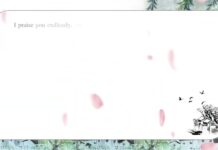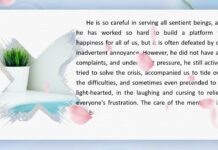–Volume 1 (Part 7)
Author: Fafu
Translator : Lotus
Dear friends, Hello everyone. Welcome to this episode of the podcast contributed by the Buddhas’ Practice Incorporated of Australia.
Today, we continue to delve deeply into the Shurangama Sutra. The background originates from the classic scene where Venerable Ananda requests teachings from the Buddha. Although Ananda is well-versed in the Buddha’s teachings, he deeply feels bound by the afflictions and cognitive obstacles, unable to awaken to the “wondrously clear true mind.” He earnestly implores the Buddha to provide guidance to help him attain the “pure eye.” With wisdom, the Buddha offers profound teachings, systematically analyzing and guiding Ananda to recognize the truth of the “nature of seeing,” dispelling attachment to “transient defilements,” and revealing the true mind that neither arises nor ceases. Below, I will share the essence of this content from three perspectives: distinguishing the nature of seeing from the eye faculty, differentiating the transient defilements from the host, and manifesting the immovable nature of seeing.
1. Distinguishing the Nature of Seeing from the Eye Faculty
When Ananda first heard the Buddha’s teachings, he mistakenly believed that “seeing” is accomplished by the eyes. The Buddha used the metaphor of a “radiant fist” and asked, ” What do you use to see?” Ananda replied, “The eyes see.” The Buddha countered, “If there were no eyes, there would be no seeing, but if there were no hand, would the radiance of the fist disappear?” Though a blind person has no eyes, they still perceive darkness before them, and this darkness is also an object of “seeing.” If the “nature of seeing” depended on the eye faculty or external conditions, a blind person should see nothing at all! This exchange strikes at the core: the eyes are merely tools. The true nature of “seeing” lies in the mind, not in the eye faculty or external radiance.
The Buddha further used the metaphor of a dark room and a lamp: in a dark room, both a sighted person and a blind person perceive darkness; when a lamp illuminates colors, only then can the eyes distinguish them. From this, it is clear that “the one who sees is the mind, not the lamp; the eyes manifest colors, but the nature of seeing is the mind, not the eyes.” This teaching dismantles the mistaken belief that the “nature of seeing” is equivalent to the senses or external conditions. The nature of seeing does not depend on the eye faculty nor changes with external conditions; it is the inherently complete, ever-undiminished true mind.
2. Identify visitors, dust and the host
To deepen Ananda’s understanding, the Buddha referenced the enlightenment story of Venerable Kaundinya. Kaundinya attained the fruit of sainthood by realizing the meaning of the two words ” visitors, dust.” He said, “That which does not abide is the visitor; that which abides is the host.” It is like a traveler temporarily staying at an inn, departing after eating and resting, while the host remains steadfast and unmoving. Similarly, when sunlight shines after the rain, dust particles dance in the air, yet the empty space remains clear and still. Kauṇḍinya summarized this as: “The clear and still is called space; the moving and shaking is called dust.”
This teaching has three layers of profound meaning:
Breaking attachment to the “visitor”: All unstable, temporary, and changing phenomena, like travelers in an inn, are considered “visitors.”
Breaking attachment to the “dust”: All fluctuating, arising-and-ceasing, and unreal phenomena, like dust in the air, are considered “dust.”
Manifesting True Nature: The “host” and the “space” represent the “self-nature,” which is still, unmoving, and neither arises nor ceases. This is the truth to be revealed after dispelling attachment to “visitors” and “dust.”
The Buddha’s teachings make us understand that clinging to impermanent phenomena—whether external conditions, the body, or thoughts—is to overlook the true mind.
3. Manifesting the Unmoving Nature of Seeing
The Buddha further guided Ananda through actions. He opened and closed his hand, asking, “Is it my hand that opens and closes, or is it your seeing that opens and closes?” Ananda replied, “The Buddha’s hand moves, but my seeing nature is not still. Who, then, is without abiding?” The Buddha then emitted light to the left and right, and Ananda’s head turned accordingly. The Buddha asked, “Is it your head that moves, or is it your seeing that moves?” Ananda replied, “My head moves on its own, but my seeing nature does not stop. Who, then, is moving?”
These dialogues point to a core truth: the nature of seeing transcends movement and stillness. The opening and closing of the hand and the turning of the head are movements of the body, yet the seeing nature “does not move” and remains unchanged by these actions.
The Buddha concluded, “That which moves is called ‘dust’; that which does not abide is called ‘visitor.’ You observe Ananda: his head moves on its own, yet his seeing does not move; my hand opens and closes on its own, yet his seeing does not expand or contract.”
This teaching dispels attachment to movement and stillness: the nature of seeing is not affected by the opening and closing of the hand or the turning of the head, transcending the duality of movement and stillness.
The Buddha ultimately revealed that sentient beings, by “taking movement as the body and movement as the environment,” with thoughts arising and ceasing, overlook their true nature. This leads to “the mind’s true nature being obscured, mistaking phenomena for the self,” causing them to cycle in samsara. This is the root of our suffering.
4. Conclusion
Friends, when we no longer follow the fluctuations of movement and stillness, nor mistake phenomena for the self, our true mind naturally manifests, and wisdom and peace follow. May we encourage one another to dispel delusion, reveal truth, and awaken in this very moment! Thank you all of you!





